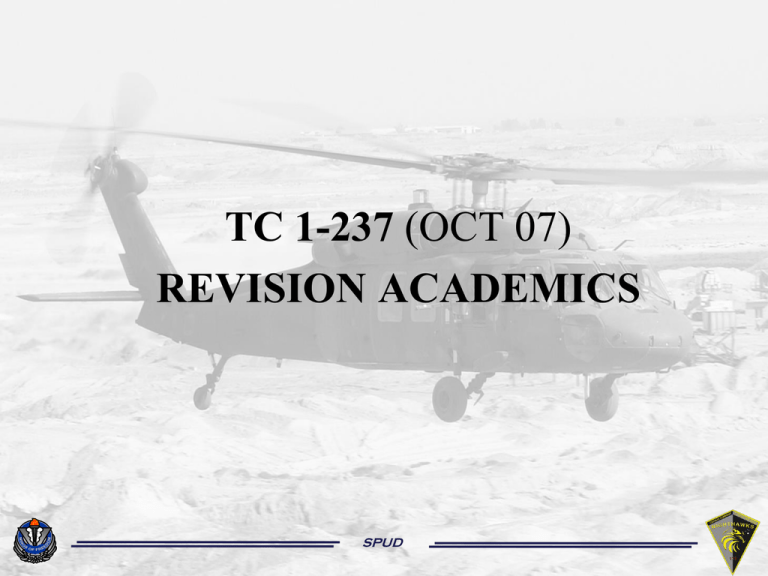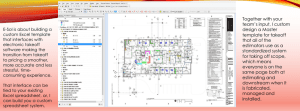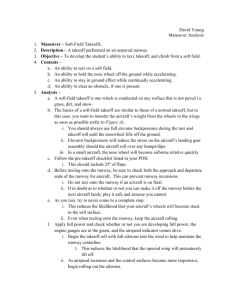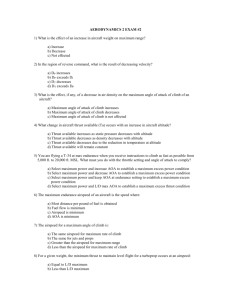task 1114 perform a rolling takeoff
advertisement

TC 1-237 (OCT 07) REVISION ACADEMICS SPUD TASK 1114 PERFORM A ROLLING TAKEOFF SPUD Rolling T/O Significant Changes – Standards STANDARDS: Appropriate common standards plus the following additions/modifications: 1. Before liftoff— a. Establish and maintain power, as necessary. b. Maintain alignment with takeoff direction ±5 degrees. c. Accelerate to desired/planned takeoff speed not to exceed 60 knots ground speed. 2. After liftoff— a. Adjust power, as required, not to exceed aircraft limits. b. Maintain ground track alignment with the takeoff direction with minimum drift. c. Maintain maximum rate of climb airspeed ±5 knots indicated airspeed (KIAS). d. Maintain aircraft aligned with runway (or suitable liftoff surface) below maximum rate of climb airspeed. e. Maintain aircraft in trim above maximum rate of climb airspeed. SPUD Rolling T/O Significant Changes – Description DESCRIPTION: 1. Crew actions. a. The pilot in command (PC) will confirm the aircraft gross weight (GWT), aircraft power available and that area is suitable for the maneuver. Considerations should include wind effects on takeoff direction, barriers/obstacles and density altitude. SPUD Rolling T/O Significant Changes – Procedures Note. A rolling takeoff may be used when hover power for takeoff is marginal or insufficient and a takeoff must be made, or as an alternate method of takeoff when sufficient power is available (dissipate dust, reduce rotor downwash). Use the rotor system thrust to accelerate the aircraft to a more efficient speed for flight. Note. For training, use 10 percent torque below the aircraft 10-foot hover torque to simulate the maximum torque available. Note. To determine maximum torque available when in ground effect (IGE) hover power is not present, apply collective, not to exceed dual engine torque and turbine gas temperature (TGT) limits, while observing the TGT. Maximum torque available will be indicated by a droop in rotor RPM with further increase in the collective. Note the torque and reduce the collective. Fluctuation in torque from flight control inputs and environmental conditions should be factored in to the torque value used for the maneuver. SPUD Rolling T/O Significant Changes – Procedures Begin accelerating the aircraft forward by smoothly applying forward cyclic while progressively increasing the collective to a power setting that will ensure that the main landing gear wheels remain in contact with the surface until takeoff airspeed is achieved. Use the pedals to maintain heading aligned with the desired takeoff direction. The tailwheel may come off the surface as the stabilator begins to produce lift with forward airspeed. SPUD How to Determine Takeoff Airspeed??? Problem: Currently, no performance charts exist to accurately determine takeoff airspeed in the UH60 Operator’s Manual. A technique/method to determine takeoff airspeed if actual dual engine hover capability does not exist (this is not described in the ATM): 1. Use the appropriate aircraft operator’s manual. 1. Enter the bottom of the appropriate CRUISE chart at 10% less than the TORQUE AVAILABLE ~ 30 MIN line (for UH-60A) or TORQUE AVAILABLE ~ 10 MIN line (for UH-60L/M). Adjust for the ATF. 1. Move up until intersecting the aircraft takeoff gross weight (GW~1000 LB) curve, then move left or right to the TRUE AIRSPEED ~ KTS. Note takeoff airspeed. 1. This airspeed will allow the aircraft to maintain dual-engine level flight at 90% of the maximum torque available. For training: A method is to use a predetermined KTAS (ex. 30 KTAS) for the takeoff airspeed. SPUD How to Determine Takeoff Airspeed??? • You have determined that your aircraft weighs 20000 lbs. • You note the FAT is 20ºC. • You adjust the barometric altimeter to 2992 and note the current PA is 6000 ft. • You open the aircraft -10 to the appropriate cruise chart in chapter 7. SPUD PA – 6000 FT Can you hover? FAT - 20ºC Acft GWT - 20000 NO SPUD Note Maximum Torque IRP – 87% Enter the chart at Maximum Torque Move straight up to IRP – right 10% to the aircraft GWT Move the true 87%airspeed - 10 % = 77% PA – 6000 FT FAT - 20ºC Acft GWT - 20000 The takeoff airspeed for this rolling takeoff is 30 KTAS 30 KTAS SPUD Rolling T/O Significant Changes – Procedures Upon reaching takeoff airspeed, adjust the collective to maximum torque available or as planned/briefed and cyclic as necessary to allow the aircraft to become airborne. Depending on liftoff speed the stabilator may cause a slight nose down attitude. At approximately 20 feet above the surface, apply forward cyclic to maintain a level acceleration to the maximum rate-of-climb airspeed. Place the aircraft in trim as soon as maximum rate of climb airspeed is achieved after the aircraft becomes airborne commensurate with surface obstacles. SPUD Rolling T/O Significant Changes – Procedures Trade off altitude as necessary to gain airspeed if the area is clear of obstacles. Maintain heading with pedals so the aircraft is aligned with the runway/surface takeoff direction when the aircraft is below maximum rate-of-climb airspeed should the takeoff need to be aborted d. Upon reaching maximum rate-of-climb airspeed, adjust the attitude to maintain the maximum rate-of-climb airspeed and maintain power as necessary until reaching the desired level-off altitude. e. The P (pilot not on the controls) will monitor torque and TGT values for the P* (pilot on the controls), and power is available and applied as planned/briefed. SPUD






